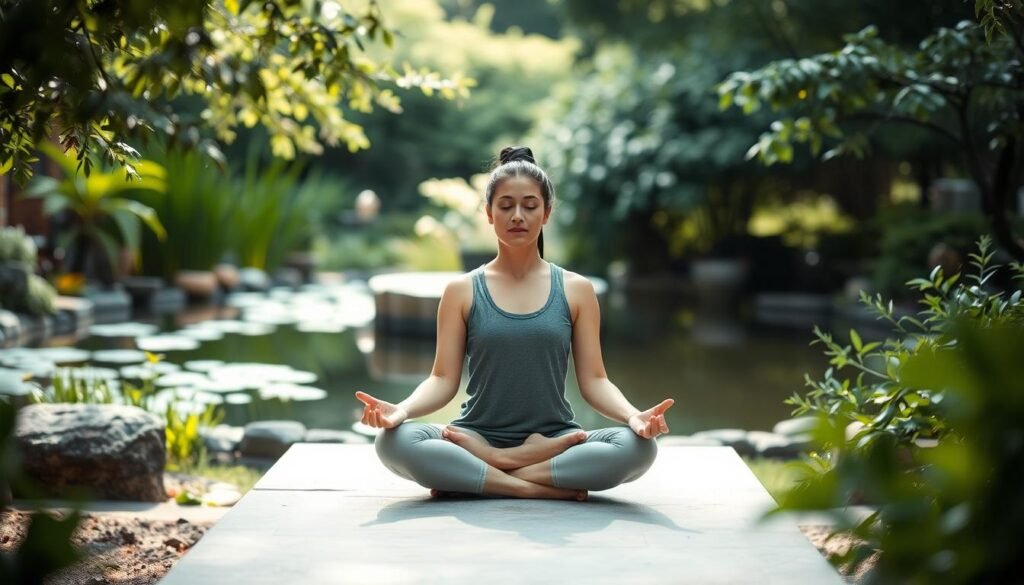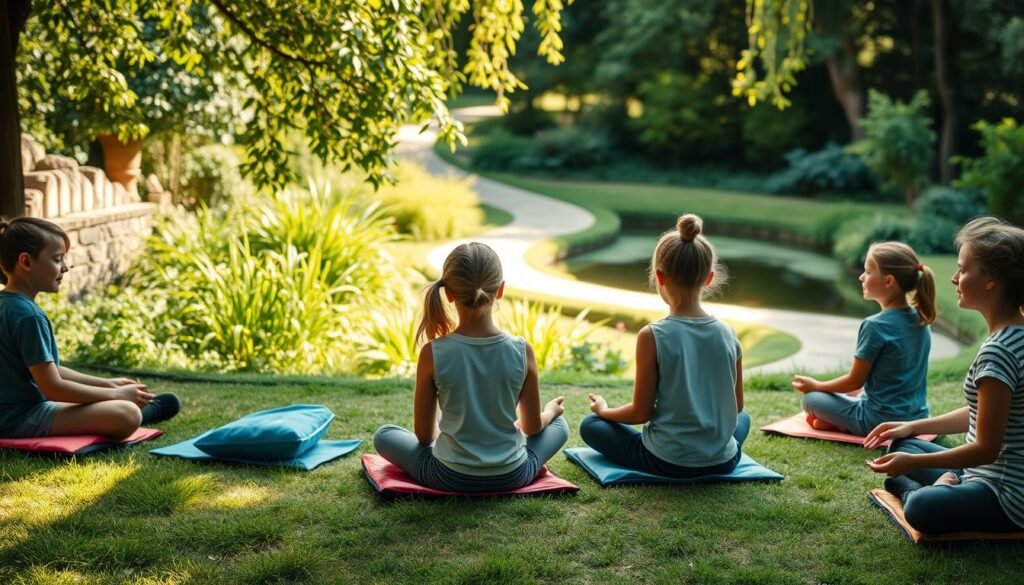In today’s fast world, finding inner peace is more important than ever. Learning about mindfulness is key for those wanting to reduce stress and improve their well-being. This ancient practice offers a simple way to emotional wellness.
By using mindfulness, you can better understand your thoughts and feelings. This leads to a more fulfilling life and true inner peace.
Key Takeaways
- Mindfulness is a powerful tool for achieving inner peace.
- Simplicity in mindfulness practices makes them accessible to all.
- Enhancing awareness of thoughts and feelings leads to emotional wellness.
- Practicing mindfulness can significantly reduce stress levels.
- Mindfulness techniques promote a more fulfilled and meaningful life.
Understanding Mindfulness and Its Importance
Mindfulness has become a key tool for mental health in recent years. The definition of mindfulness is about being fully aware of our thoughts, feelings, and surroundings right now. It helps us stay in the present, without thinking about the past or worrying about the future.
What is Mindfulness?
Mindfulness is about being fully present and aware. It means watching our thoughts and feelings without judging them. This understanding mindfulness helps us stay focused, even when things get tough. It opens the door to discovering ourselves and growing as individuals.
Why is Mindfulness Essential for Well-being?
Mindfulness is more than just a way to relax; it’s crucial for our overall well-being. The importance of mindfulness goes beyond stress relief. It helps us manage our emotions and stay strong in the face of challenges. Studies show that mindfulness can change our lives for the better.
By making mindfulness a part of our daily lives, we can think more clearly. This leads to better decision-making and focus.
The Benefits of Practicing Mindfulness
Mindfulness in daily life brings many benefits. It improves focus and concentration. It also helps with stress relief and emotional wellness.
Improved Focus and Concentration
Mindfulness sharpens focus and concentration. It trains the mind to stay present. This makes tasks more efficient and accurate.
It leads to better decision-making and productivity. This is true in both personal and work life.
Reduced Stress and Anxiety
Mindfulness is great for stress relief. It lowers anxiety levels, making the mind calmer. Practicing mindfulness helps manage overwhelming thoughts.
This leads to less stress and anxiety. It makes for a more peaceful mental state.
Enhanced Emotional Regulation
Mindfulness also boosts emotional wellness. It helps regulate emotions, allowing for better responses to situations. Understanding and acknowledging feelings is key.
This way, people can handle emotional challenges better. They can also keep relationships balanced.
How to Get Started with Mindfulness
Starting with mindfulness means setting up a space and routine that supports your practice. A mindful environment helps you stay in the present moment. It’s important to pick a good spot and stick to regular times for a successful mindfulness journey.
Finding the Right Environment
Finding a quiet spot that feels safe and comfortable is key. This place should be free from distractions, helping you relax and reflect. Consider these factors:
- Natural light and fresh air
- Minimalistic decor to reduce clutter
- Comfortable seating or cushions
Having a special spot for mindfulness tells your brain it’s time to focus on yourself.
Setting Aside Dedicated Time
Effective mindfulness requires setting aside specific times each day. This helps you make mindfulness a priority. Here are tips for setting aside mindfulness time:
- Choose a time that fits your natural rhythm, like early mornings or quiet evenings.
- Begin with short sessions and gradually make them longer.
- Use reminders or calendars to keep mindfulness on your mind.
Different Mindfulness Techniques
Exploring various mindfulness techniques can greatly improve your practice and well-being. These methods help you become more aware, relaxed, and connected to the present. Each technique has its own purpose, making it easy to find what works best for you. We’ll look at different practices, from meditation to daily mindfulness routines.
Meditation for Mindfulness
Meditation is a key part of mindfulness. Many use it to clear their minds and focus better. Regular sessions help keep thoughts in check and reduce mental clutter. There are many styles to choose from, fitting different lifestyles and preferences.
Mindful Breathing Exercises
Mindfulness breathing focuses on your breath to calm your mind. You can do it anywhere. It helps shift your focus from stressors, leading to greater calmness. This practice is great for managing anxiety and finding emotional balance.
Body Scan Technique
The body scan technique helps you notice physical sensations. By focusing on each body part, you can release tension and find discomfort. It’s a powerful way to understand your body’s stress responses and relax deeper.
Mindfulness in Daily Activities
Mindfulness in daily activities makes life more conscious. Doing tasks like eating, walking, or washing dishes with full attention makes them more enjoyable. It helps you appreciate life’s simple pleasures, making everyday activities more fulfilling.
| Mindfulness Technique | Key Focus | Benefits |
|---|---|---|
| Meditation | Clearing the mind | Improved focus, reduced stress |
| Mindful Breathing | Aware of breath | Calming effect, anxiety management |
| Body Scan | Physical sensations | Release tension, body awareness |
| Daily Activities | Present moment awareness | Enhanced enjoyment, life appreciation |
Creating a Mindfulness Routine
Creating a mindfulness routine is key to making mindfulness a part of your daily life. It helps you grow deeper in your practice and keeps you committed. By setting up daily habits, you build a strong foundation for ongoing growth and self-reflection.
Daily Practices for Consistency
- Morning Mindfulness: Begin your day with a short meditation or mindful breathing. It sets a positive note for the day.
- Mindfulness Breaks: Take short pauses during the day to breathe and connect with the moment.
- Evening Reflection: End your day with reflection. Review your day and write in a mindfulness journal.
- Mindful Movement: Try yoga or tai chi to mix mindfulness with physical activity.
Tips for Staying Committed
- Track Your Progress: Keep a journal or use an app to track your mindfulness. See how you’ve grown over time.
- Set Reminders: Set reminders on your phone to stay on track with your mindfulness routine.
- Evaluate Your Experience: Check how your mindfulness affects your mind and emotions regularly.
- Accountability Partners: Share your mindfulness journey with a friend or community. It helps with motivation and support.
Overcoming Common Mindfulness Challenges

Mindfulness can face many challenges that might make it hard to keep up. It’s key to know these obstacles to stay focused and calm. Finding ways to beat distractions and manage time helps make mindfulness a part of everyday life.
Dealing with Distractions
Distractions come from outside and inside us. Setting clear boundaries during mindfulness time can help a lot. Having a special place for mindfulness makes it feel safer and calmer.
Using background sounds or apps can help stay focused. Techniques like breathing exercises or guided meditations keep the mind in the present.
Managing Time Constraints
Time is a big issue in our fast world. Setting aside small blocks for mindfulness is a good start. Adding mindfulness to daily activities like eating or traveling makes it easier for busy people.
Starting with short periods each day makes it easier to do more as time goes on. This way, mindfulness doesn’t feel too much to handle.
Mindfulness and Mental Health
Mindfulness is key for good mental health, especially for anxiety and depression. It helps people feel better emotionally. Studies show that regular mindfulness practice can help reduce anxiety and depression symptoms.
Mindfulness in Treating Anxiety Disorders
Mindfulness helps treat anxiety by focusing on the present. It lets people step away from anxious thoughts. Meditation and deep breathing help stay grounded, easing anxiety.
Research shows mindfulness in therapy can lessen anxiety. It teaches coping skills that build resilience.
The Role of Mindfulness in Depression
Mindfulness does more than just ease symptoms of depression. It lets people watch their thoughts and feelings without judgment. This helps understand emotions better.
By accepting sadness without getting overwhelmed, one can change their outlook. Mindfulness offers a way to manage depression.
Integrating Mindfulness into Work Life
Mindfulness at work is a great way for companies to help their employees feel better and work better. It helps manage stress and makes teams work better together. This change helps everyone at work feel and do their best.
Mindfulness for Stress Management at Work
Mindfulness gives workers simple ways to deal with stress. Mindful breathing and meditation help them stay in the moment. This reduces anxiety from work. Regular mindfulness training can lead to:
- Less stress and burnout.
- Being more emotionally strong when things get tough.
- Doing a better job because they focus better.
Enhancing Team Dynamics Through Mindfulness
Mindfulness makes the workplace a better place for teamwork. It helps team members listen and talk to each other better. Mindfulness in team meetings can lead to:
- Working together better and more.
- Less arguing and misunderstandings.
- More new ideas from different viewpoints.
Mindfulness for Children and Teens

Teaching mindfulness to kids and teens can greatly benefit their emotional health. It helps them develop important life skills like self-awareness and empathy. By focusing on the present, they learn to handle stress and emotions better.
This section will look at the advantages of mindfulness for young people. It will also share easy ways to make mindfulness fun for them.
Benefits of Teaching Mindfulness Early
Teaching mindfulness to children can help them:
- Improve their emotional intelligence by understanding and managing their feelings.
- Stay focused in school and other activities.
- Find ways to deal with anxiety and stress.
- Make better connections with friends and adults by being more empathetic.
- Gain self-control, reducing impulsiveness and anger.
Simple Mindfulness Exercises for Kids
Making mindfulness a part of daily life can be enjoyable. Here are some easy exercises for different age groups:
- Mindful Breathing: Teach kids to breathe deeply and slowly. Have them count their breaths, focusing only on the air moving in and out.
- Nature Walks: On walks, ask kids to notice and describe what they see, hear, and smell around them.
- Mindful Listening: Play calming sounds or music. Have kids close their eyes and try to identify the different noises.
- Feelings Check-In: Ask kids to stop and share how they’re feeling. Talk about what might have caused those emotions.
- Gratitude Journaling: Have kids write down three things they’re thankful for each day. This helps them focus on the positive.
The Science Behind Mindfulness
The science of mindfulness looks into how it changes the brain and improves well-being. Many studies have explored these topics, showing the growing interest in mindfulness. These studies found that mindfulness can change the brain’s structure and function.
Research on Mindfulness and the Brain
Recent studies have shown that mindfulness meditation changes the brain. It affects areas like emotional control, attention, and self-awareness. For example, the prefrontal cortex, which helps with decision-making, gets thicker in regular practitioners.
This change means better control over emotions and thoughts.
Case Studies Highlighting Mindfulness Benefits
Real-life examples show the benefits of mindfulness. People who practice mindfulness daily report less stress and anxiety. They also feel more emotionally resilient.
These stories add to the evidence that mindfulness improves life quality.
Mindfulness and the Power of Gratitude
Mindfulness and gratitude can greatly improve emotional well-being. Gratitude helps people focus on the good things in life. This makes their mindfulness practice stronger. It also makes daily life more rewarding.
How Gratitude Enhances Mindfulness Practice
Gratitude is a key to better mindfulness. By noticing and valuing the good in each moment, it boosts mindfulness. People who are thankful often notice more around them and feel their emotions more deeply. This change helps them stay in the moment, turning everyday moments into special ones.
Daily Gratitude Exercises
Adding daily gratitude exercises to mindfulness can be very helpful. Here are some simple ways to do it:
- Gratitude Journaling: Spend a few minutes each day writing down what you’re thankful for. It helps make mindfulness a regular habit.
- Morning Affirmations: Start your day by saying three things you’re grateful for. It sets a positive tone for the day and supports mindfulness.
- Gratitude Walk: Take a walk and focus on the beauty of nature or the people around you. It combines movement with gratitude, boosting mindfulness.
Resources for Further Mindfulness Exploration
Exploring mindfulness further requires access to valuable resources. These resources guide individuals on their journey. Books on mindfulness offer insights and techniques for a deeper understanding. Mindfulness apps also provide a way to integrate mindful practices into daily life.
Books and Literature on Mindfulness
Many authors have made significant contributions to mindfulness through their writings. Here are some highly recommended books:
- The Miracle of Mindfulness by Thich Nhat Hanh
- Wherever You Go, There You Are by Jon Kabat-Zinn
- The Mindful Way Through Depression by Mark Williams, John Teasdale, Zindel Segal, and Jon Kabat-Zinn
- Mindfulness in Plain English by Bhante Henepola Gunaratana
Apps to Support Your Mindfulness Journey
Mindfulness apps are a practical way to keep up with mindfulness practices. They offer guided meditations, reminders, and tracking tools. This makes mindfulness easy to access:
| App Name | Features | Platform |
|---|---|---|
| Headspace | Guided meditations, courses, sleep sounds | iOS, Android |
| Calm | Daily meditations, sleep stories, breathing programs | iOS, Android |
| Insight Timer | Free guided meditations, community features | iOS, Android |
| 10% Happier | Expert-led courses, daily meditation challenges | iOS, Android |
Mindfulness Retreats and Workshops
Mindfulness retreats and workshops offer deep opportunities for self-discovery. They create a special place for personal growth. Here, you can learn a lot and connect with others who share your interests.
Benefits of Attending a Mindfulness Retreat
Mindfulness retreats bring many benefits. They help deepen your practice and offer expert guidance. You also get to meet others on similar paths, creating lasting connections.
- Deepening Practice: A retreat lets you focus without distractions, leading to a deeper experience.
- Professional Guidance: You get feedback and support from experienced teachers.
- Connections: Sharing your journey with others can lead to meaningful friendships.
- Holistic Healing: These settings help with emotional and physical health, reducing stress and anxiety.
What to Expect from a Mindfulness Workshop
Mindfulness workshops introduce you to key techniques. You can look forward to:
- Interactive Activities: Expect exercises like guided meditations and group talks that engage your senses.
- Practical Tools: Learn methods you can use every day.
- Supportive Atmosphere: Share your experiences and learn from others in a supportive setting.
- Resource Materials: Get materials to help you keep practicing after the workshop.
Conclusion: Embracing Mindfulness for Inner Peace
As we wrap up our look at mindfulness, it’s clear that it’s more than just a practice. It’s a journey to inner peace. Each method we’ve talked about is a step on this path. Whether you’re new to mindfulness or have been practicing for years, keep at it.
Making Mindfulness a Lifelong Journey
Mindfulness in daily life brings many benefits, like better focus and less stress. It helps you understand yourself and control your emotions. Seeing mindfulness as a lifelong journey helps you stay strong and adapt to changes.
Regular mindfulness practice feeds your mind and spirit. It helps you understand yourself better and live a more fulfilling life.
Your Path to Greater Inner Peace
Everyone’s path to inner peace is different, based on their experiences and views. Thinking about your mindfulness journey helps you see the value in small moments. Mindfulness as a long-term practice helps you live a peaceful, balanced, and meaningful life.
Stay committed to exploring mindfulness. It will lead you to lasting peace and calm.



